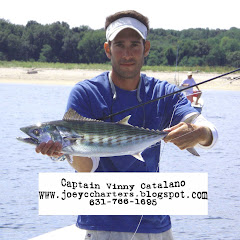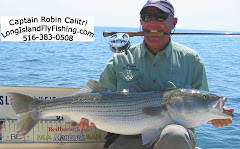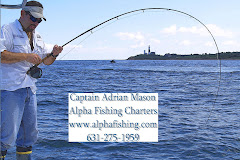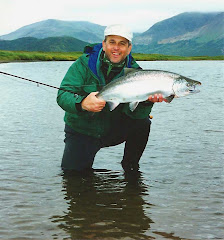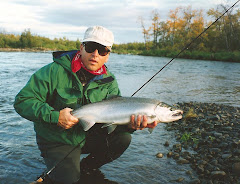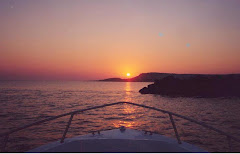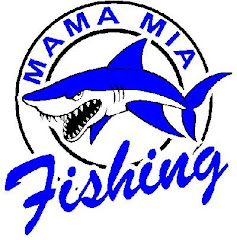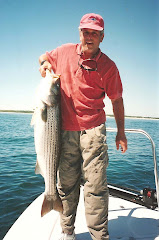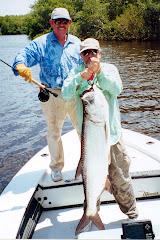Thursday, October 22, 2009
See Bass Run
It’s happening, it has happened, it will happen. Those are the tenses used to describe the fishing during the past week. One’s view of the fall run is totally dependent on where and when you fish. For example, Montauk seems to be on one day and off the next. A friend of mine left a message on my phone that he enjoyed a few days of terrific fishing in the Montauk rips for bass up to 35-pounds. A couple of other light tackle guides I know fishing the Point and the southside reported having to work very hard to make a decent day of fishing for their clients. The north shore has spurts of activity with bass and bluefish making an appearance along the beaches and then a day later the only game in town is blackfish. And then some good bass, blues and even a few leftover bonito showed up at Mt. Sinai Harbor. The western Sound produced some nice bass this week with a number of fish into the mid 20’s. The folks over on the CT side are still into bass, blues and the occasional albie. The south shore beaches can be hot as a firecracker one tide and all quiet the next. J-Bay has been active as have been some of the beaches in northern New Jersey but even that fishing has been far from predictable. The most consistent shot at the Long Island Hat Trick has been in the area of the Race where some of last week’s hottest albie action took place. The south shore beaches from The End down to Moriches have yielded mostly bass and blues this past week with some sustained blitzes in the foam.
Monday, September 7, 2009
Fall Coming to Long Island

As the summer nears it traditional end we see the local fishing scene in its state of annual transition. This past weekend’s weather sent August out on a wet note and kept anglers off the water. Big bluefish continue to dominate the light tackle and fly scene but most of those catches this past week on the north shore have been offshore of some of the more notable locations like the Middle Grounds, Stratford Shoal, Crane Neck and the Triangle. Some good bass were also taken this past week, but most feel to rigged eels. The harbors are still holding both schoolies and keeper bass and many are falling to light tackle and flies. There are numerous snappers around now in the harbors and bays so if you want some fun grab a 2 or 3-weight fly outfit and give them a go. They can pull better than most stocked trout! There were some isolated reports of a few bonito landed in the Fire Island and Shinnecock Inlet areas but still very few landing reports on the north side of the Island. Such is the same situation across the Sound in Connecticut. We have not yet seen any large concentrations of fish in our local near shore waters. The only substantiated bonito reports have been from the extreme east end of the Sound. Albies so far have been scarce to non-existent inshore but are still being caught off the deep lumps and holes along with skipjack and bones. There is still some fabulous inshore fishing for various species of tuna off the near-New Jersey coast, making for some fine fly and light tackle fishing. While our spring runs have, as of late, been more of an event than the fall runs – with the notable exception of Montauk- there is a lot to be hopeful for with the congregations of bait that are amassing. Sand eels are so thick off the east end that they have attracted whales. New England areas are seeing much the same phenomenon. All that bodes well for a solid Montauk and south shore run…the bass are already there! That run is a paradise for fly and light tackle anglers.
Sunday, July 12, 2009
Hosted Alaska Fly Fishing Trips

Alaska is one of the finest fly-fishing destinations on earth. I took my first trip in 1989 and have been on many annual trips since, fishing for king salmon, silver salmon, chums, sockeye and pinks, as well an indigenous species - char, graying, dollies and magnificent rainbow trout. I have a unique opportunity to host a small groups of fly anglers at several remote lodges during the 2010 season. Good fishing in Alaska requires advance preparation to ensure prime weeks for the targeted species. You would be surprised at how many anglers make the mistake of selecting the wrong times for the species they would like to catch and end up verky disapponted. My experiences can help you avoid those costly mistakes that can ruin the trip of a lifetime. If you are interested please reposnd to me at apdotcominfo@aol.com for further details. Thank you. AP
Sunday, June 28, 2009
August in Alaska

August is an exceptional time to be in Alaska. It is a month blessed with an extraordinary abundance of game fish, all quite eager to engage the visiting fly-fisher in continuous contest. It is a time when the much heralded silver salmon make their stage debut, entering the many small, flyfishing-friendly rivers throughout the state. This time of year also witnesses the aggressiveness of indigenous rainbow trout as they bulk up on the nutrient rich eggs of the millions of sockeye salmon now in full spawning mode. During August,one also has the opportunity to introduce a multitude of egg- fly patterns too large numbers of hungry grayling and char and Dolly Varden, since they too are now enjoying a natural buffet consisting of this unique form of caviar. The spawning salmon attract the magnificent bald eagles that feast on the remains of spent and dying fish. This is also a time when one of Alaska largest carnivores, brown bears, bulk up on a seemingly endless supply of spawning salmon, building fat reserves to carry them through winter hibernation. It is fair to say that the presence of salmon in Alaskan rivers attracts all varieties of wildlife that benefit from this most natural of all resources. The fish also attract an abundance of anglers. But Alaska is a big state and one can find spectacular solitude and fly-fishing beyond comparison. Yes, August is my favorite time to fish the Greatland, especially the AK Peninsula. When I am there you will be sure to find me on some remote tidal spawning stream, fly rod in hand searching for hard fighting and bright silvers. See you in the bush!
Thursday, April 16, 2009
Weatherby's: A "Grand" Destination

I first visited Grand Lake Stream Maine in July 1988 and became as hooked on the region as were the fish I caught. My wife and I traveled to this destination as part of a summer road trip that included sightseeing and fishing. While the tourist part of the trip was most enjoyable, the fishing was nothing short of spectacular, especially for smallmouth bass. Our mid-summer adventure did not necessarily coincide with peak spring and fall smallmouth fishing, but you could have fooled me. No matter where we ventured, we caught bass, and lots of them. Most were fish in the 1-½ to 2-pound class but there were enough quality fish in the 3 and 4-pound range to keep me on my toes after each cast. We fished for five days and literally lost count of bass that certainly numbered in the hundreds. I have been back this region many times since and often refer to the area’s fishery as a smallmouth bass factory. And if the smallies aren’t enough to keep you occupied, Grand Lake Stream proper is home to some exciting fishing for landlocked salmon.
One of my favorite bass fishing spots is the St. Croix River, bordered by Maine on one side of the river and Canada on the opposing bank. I would always begin and end my trips to this region with a float on the St Croix. Nothing quite beats the aesthetics of fishing the St Croix in a traditional Grand Laker canoe and enjoying a timeless Maine shore lunch. The upper reaches of the St Croix hold some very magical smallmouth waters and prolific populations of fish. Flies, small plugs and any assortment of plastic baits work wonders on those river bass. But the St. Croix is far from the only game in town. Grand Lake is a classic Down East smallmouth bass water, replete with boulders, shoreline structure, coves, creek inlets and deep water holding areas. For a taste of Maine “wilderness” fishing, Third Lake Machias can’t be beat. It is one of a chain of Machias Lakes that includes First Lake through Fifth Lake. All Machias lakes are wonderful and productive places to fish; Third Lake has yielded some of the best dragon fly-fishing for smallmouth bass I have ever experienced. During the course of my visits I have also been treated to day expeditions to other places like Pocomoonshine Lake, Big Lake, East Lake, West Lake and Long Lake. I have never been disappointed by the outcome on any of the area’s waters.
The smallmouth season typically begins in late May as the air and water temperatures steadily increase and become more consistent. The pre-spawn and post-spawn bass fishing can be as good as it gets anywhere, with 50 to 100 fish days not that uncommon. The month of June offers high quality finest top water smallie fishing with popping bugs or topwater plugs. The fishing remains productive throughout the summer months with flies and a variety of artificial baits quite effective. The season runs through September, a month known for fast action and big fish
This region is one of four in Maine that have native populations landlocked salmon - cousin the mighty Atlantic salmon. One major difference between the landlocked salmon and its larger relative is that the landlocked salmon are actively feeding while in the Stream during the summer. The season for the salmon begins early May after the ice leaves our lakes and they follow the smelt, a favorite forage fish, into Grand Lake Stream. Not long after the white suckers move it to spawn another wave of salmon targeting the sucker eggs follows. Late May and June bring the May fly and caddis hatches, followed by alder flies, stoneflies and other terrestrials in July. Typically during mid-summer the salmon move to the deep pools or into the lakes to feed, only to return in late September and October to spawn. We fish until October 20 and experience tremendous fishing for large salmon in the spawning dress during this time.
Your best choice for a base of operation for your Grand Lake Stream adventure is Weatherby’s, an outstanding historic lodge situated in the heart of town. Weatherby’s offers central access to some unique landlocked salmon fishing and is a hub location for spring boarding to the areas unsurpassed smallmouth bass fishing. The lodging, food and hospitality are second to none and Weatherby’s also boasts one of the most professional cadre of skilled guides available anywhere. The lodge is one of the oldest and most famous fishing destinations in North America. Many famous visitors have stayed and played outdoors using Weatherby’s as a their home base, including the “splendid splinter” himself, Ted Williams.
Weatherby’s is also an excellent destination upland game hunting. The area is renowned for woodcock or “timberdoodle” shooting.
One of my favorite bass fishing spots is the St. Croix River, bordered by Maine on one side of the river and Canada on the opposing bank. I would always begin and end my trips to this region with a float on the St Croix. Nothing quite beats the aesthetics of fishing the St Croix in a traditional Grand Laker canoe and enjoying a timeless Maine shore lunch. The upper reaches of the St Croix hold some very magical smallmouth waters and prolific populations of fish. Flies, small plugs and any assortment of plastic baits work wonders on those river bass. But the St. Croix is far from the only game in town. Grand Lake is a classic Down East smallmouth bass water, replete with boulders, shoreline structure, coves, creek inlets and deep water holding areas. For a taste of Maine “wilderness” fishing, Third Lake Machias can’t be beat. It is one of a chain of Machias Lakes that includes First Lake through Fifth Lake. All Machias lakes are wonderful and productive places to fish; Third Lake has yielded some of the best dragon fly-fishing for smallmouth bass I have ever experienced. During the course of my visits I have also been treated to day expeditions to other places like Pocomoonshine Lake, Big Lake, East Lake, West Lake and Long Lake. I have never been disappointed by the outcome on any of the area’s waters.
The smallmouth season typically begins in late May as the air and water temperatures steadily increase and become more consistent. The pre-spawn and post-spawn bass fishing can be as good as it gets anywhere, with 50 to 100 fish days not that uncommon. The month of June offers high quality finest top water smallie fishing with popping bugs or topwater plugs. The fishing remains productive throughout the summer months with flies and a variety of artificial baits quite effective. The season runs through September, a month known for fast action and big fish
This region is one of four in Maine that have native populations landlocked salmon - cousin the mighty Atlantic salmon. One major difference between the landlocked salmon and its larger relative is that the landlocked salmon are actively feeding while in the Stream during the summer. The season for the salmon begins early May after the ice leaves our lakes and they follow the smelt, a favorite forage fish, into Grand Lake Stream. Not long after the white suckers move it to spawn another wave of salmon targeting the sucker eggs follows. Late May and June bring the May fly and caddis hatches, followed by alder flies, stoneflies and other terrestrials in July. Typically during mid-summer the salmon move to the deep pools or into the lakes to feed, only to return in late September and October to spawn. We fish until October 20 and experience tremendous fishing for large salmon in the spawning dress during this time.
Your best choice for a base of operation for your Grand Lake Stream adventure is Weatherby’s, an outstanding historic lodge situated in the heart of town. Weatherby’s offers central access to some unique landlocked salmon fishing and is a hub location for spring boarding to the areas unsurpassed smallmouth bass fishing. The lodging, food and hospitality are second to none and Weatherby’s also boasts one of the most professional cadre of skilled guides available anywhere. The lodge is one of the oldest and most famous fishing destinations in North America. Many famous visitors have stayed and played outdoors using Weatherby’s as a their home base, including the “splendid splinter” himself, Ted Williams.
Weatherby’s is also an excellent destination upland game hunting. The area is renowned for woodcock or “timberdoodle” shooting.
For further information about accomodations, seasons and rates visit the lodge's website at http://www.weatherbys.com/ .
Saturday, April 11, 2009
Long Island - A World Class Destination

Long Island, New York enjoys a well earned reputation as a world-class fishing destination. The availability of outstanding freshwater and saltwater angling draws anglers from far and near. The saltwater oppportunities are as plentiful and diverse as any other destination and offer superb inshore, offshore and flats fishing.
An Impressive Array of Records...
The waters surrounding Long Island have relinquished a remarkable number of fish to the record book, from diminutive perch and catfish to offshore giants. As one might imagine, the majority of records attributed to Long Island are saltwater milestones but there are a couple of freshwater line class records in the big book and some fly fishing records as well. As one peruses the book some extraordinary accomplishments jump off the page and are most worthy of special note.
Some Long Island records are truly astounding accomplishments and are hall of fame-type catches. Most of these are line-class records where large fish were taken on small lines. Others are truly extraordinary specimens of a game fish species. While all of the Long Island records represent significant achievements the following are a few that catch the eye:
- Stephen Sloan took three blue sharks weighing 119 pounds, 184 pounds and 251 pounds on 2, 4 and 6-pound test line respectively! Stephen also landed a 91-pound blue shark on a fly rod with a 4-pound class tippet, and another blue of 114 pounds, 12 ounces on a 6-pound fly rod tippet!
- Tred Barta landed a 63-pound, 12-ounce yellow fin on 6 pound test line!
- Emme Golinski landed two large striped bass of 46 pounds, 12 ounces and 57 pounds, 15 ounces on 6 and 8-pound test line respectively!
- Dr. Einar Grell dredged a massive 18 pound, 3 ounce fluke up from the
depths on 6 pounds test line!
- Diane Mellish bested a 26 pound, 12 ounce pollock on 4-pound test line!
- Bob Rochetta’s 76-pound striped bass!
- Chester Berry’s 70-pound striped bass!
- Ann Houseknecht’s 63 pound, 2 ounce Atlantic cod!
- Joe Seidel’s 528-pound blue shark!
- Jame’s Melanson’s 1,080 pound mako shark!
- Charles Nappi’s 22 pound, 7 ounce fluke!
- Dennis Rooney’s 19 pound, 2 ounce weakfish!
- Mark Kaminski’s 56 pound, 5 ounce tilefish!
- Mason Horn’s Junior/Smallfry striped bass of 57 pounds!
- Joseph Marino’s Junior/Smallfry bluefish of 22 pounds, 8 ounces!
- Kevin Dunckley’s oversized Junior/Smallfry Spanish mackerel of
11 pounds, 13 ounces!
(Source of records: IGFA Record Book)
Some Long Island records are truly astounding accomplishments and are hall of fame-type catches. Most of these are line-class records where large fish were taken on small lines. Others are truly extraordinary specimens of a game fish species. While all of the Long Island records represent significant achievements the following are a few that catch the eye:
- Stephen Sloan took three blue sharks weighing 119 pounds, 184 pounds and 251 pounds on 2, 4 and 6-pound test line respectively! Stephen also landed a 91-pound blue shark on a fly rod with a 4-pound class tippet, and another blue of 114 pounds, 12 ounces on a 6-pound fly rod tippet!
- Tred Barta landed a 63-pound, 12-ounce yellow fin on 6 pound test line!
- Emme Golinski landed two large striped bass of 46 pounds, 12 ounces and 57 pounds, 15 ounces on 6 and 8-pound test line respectively!
- Dr. Einar Grell dredged a massive 18 pound, 3 ounce fluke up from the
depths on 6 pounds test line!
- Diane Mellish bested a 26 pound, 12 ounce pollock on 4-pound test line!
- Bob Rochetta’s 76-pound striped bass!
- Chester Berry’s 70-pound striped bass!
- Ann Houseknecht’s 63 pound, 2 ounce Atlantic cod!
- Joe Seidel’s 528-pound blue shark!
- Jame’s Melanson’s 1,080 pound mako shark!
- Charles Nappi’s 22 pound, 7 ounce fluke!
- Dennis Rooney’s 19 pound, 2 ounce weakfish!
- Mark Kaminski’s 56 pound, 5 ounce tilefish!
- Mason Horn’s Junior/Smallfry striped bass of 57 pounds!
- Joseph Marino’s Junior/Smallfry bluefish of 22 pounds, 8 ounces!
- Kevin Dunckley’s oversized Junior/Smallfry Spanish mackerel of
11 pounds, 13 ounces!
(Source of records: IGFA Record Book)
A few key findings might prove helpful if you are interested in fishing Long Island and taking a shot at landing a record of your own, or just gaining some insight from the current records to aid in your own fishing.
- Of the total Long Island records 34% were caught during the dogs days of summer, July and August. There are a total of 94 Long island records in the book.
- When adding in the records for the month of October to those of July and
- August, the total represents a full 51% of all record fish taken. Each of the three months carries a 17% share of the total.
- No record fish were taken in the months of March and April.
- Six of the total records were taken during the winter months.
- 45% of the record fish were taken in the months of May (7%), June (12%), September (15%) and November (11%).
- Of the total Long Island records 34% were caught during the dogs days of summer, July and August. There are a total of 94 Long island records in the book.
- When adding in the records for the month of October to those of July and
- August, the total represents a full 51% of all record fish taken. Each of the three months carries a 17% share of the total.
- No record fish were taken in the months of March and April.
- Six of the total records were taken during the winter months.
- 45% of the record fish were taken in the months of May (7%), June (12%), September (15%) and November (11%).
Thursday, April 2, 2009
 The Northeast United States is home to some of the finest saltwater fishing our planet has to offer. It is a destination all serious fly anglers should fish. Saltwater Flies of the Northeast, authored by Angelo Peluso and published by Frank Amato Publishing(Portland Oregon) will serve as an essential reference guide for both beginning and advanced fly anglers and fly tyers. It is also a window on the world of some of the region's most successful fly fishermen. It contains the profiles of exceptional flies of more than 100 professional and amateur tyers, guides and captains. Their designs and patterns have been successfully fished regionally - from the southern tip of New Jersey up through the rugged coastline of Maine, and most all locations in between. Within these pages are the "go-to" designs that each contributing fly tyer, professional guide and captain uses when the going gets tough.
The Northeast United States is home to some of the finest saltwater fishing our planet has to offer. It is a destination all serious fly anglers should fish. Saltwater Flies of the Northeast, authored by Angelo Peluso and published by Frank Amato Publishing(Portland Oregon) will serve as an essential reference guide for both beginning and advanced fly anglers and fly tyers. It is also a window on the world of some of the region's most successful fly fishermen. It contains the profiles of exceptional flies of more than 100 professional and amateur tyers, guides and captains. Their designs and patterns have been successfully fished regionally - from the southern tip of New Jersey up through the rugged coastline of Maine, and most all locations in between. Within these pages are the "go-to" designs that each contributing fly tyer, professional guide and captain uses when the going gets tough.This comprehensive book contains beautiful photographs and stunning artwork, plus descriptions and recipes for 370 of the most effective Northeast saltwater fly patterns being used today. An indispensable guide for fly tying, this book will become a "must-have" for the serious or aspiring saltwater fly tyer and fly angler on either coast.
Angelo lives and fishes on Long Island. Copies of the book can be purchased directly from the author at angelopeluso.com or emailing him at Apdotcominfo@aol.com. The book is also available at all major retail outlets, online booksellers and various fishing shops throughout the region.
 FLY FISHING LONG ISLAND is now available... If your travels take you to Long Island and if you enjoy fly-fishing then this book is a must have. Fly Fishing Long Island by Angelo Peluso (WW Norton and Company/Countryman Press) is the most comprehensive guidebook ever written about freshwater and saltwater fly-fishing on Long Island.
FLY FISHING LONG ISLAND is now available... If your travels take you to Long Island and if you enjoy fly-fishing then this book is a must have. Fly Fishing Long Island by Angelo Peluso (WW Norton and Company/Countryman Press) is the most comprehensive guidebook ever written about freshwater and saltwater fly-fishing on Long Island.Long Island has long been known as a fisherman's paradise - now it's been rediscovered as a world-renowned saltwater fly fishing destination with equally impressive freshwater opportunities. The fall runs of striped bass, bluefish and false albacore draw anglers from far and near. The Island also boasts world-class freshwater fisheries with opportunities for sea-run brown trout and rainbow trout; bass and panfish also abound in lakes and ponds.
While much has been written about various aspects of Long Island's fly fishing opportunities, Fly Fishing Long island is the first comprehensive compilation of all that Long Island has to offer. Fly Fishing Long Island highlights everything the experienced - or the novice - angler needs to know, ranging from destination information to how to catch the available variety of game fish species.
Angelo is a regular columnist for the New York and Long Island edition of The Fisherman Magazine, as well as a contributor to numerous local, regional and national publications His previous book, Saltwater Flies of the Northeast, is an acclaimed best seller. His writings and photography have been recognized by the New York State Outdoor Writers Association, the Outdoor Writers Association of America and the Association of Great lakes Outdoor Writers.
Angelo lives and fishes on Long Island. Copies of the book can be purchased directly from the author at angelopeluso.com or emailing him at Apdotcominfo@aol.com. The book is also available at all major retail outlets, online booksellers and various fishing shops throughout the region.
A New Season Looks Back...

I have been contemplating this new blog for quite some time. The only excuse that I can offer for not publishing it sooner is that fishing, life and a couple of new book projects got in the way. Please feel free to blame my neglect to publish squarely on many game fish species that kept me very busy last season. And I guess while we are at the blame game we can cast some culpability in the direction of those darn baitfish that amassed in incredible number all up and down the northeast coast, Long Island included. By the late summer of 2008 there were literally acres and acres of peanut bunker, spearing, anchovies and other forms of micro-bait in residence. Once the various game fish zoned in on this bait buffet they fed with a vengeance. This is a new season but hopefully, 2009 will be a repeat performance.
It would be fair to say that most anglers experienced a reasonbale run of striped bass in 2008. There certainly was numerous large bass caught. Once the sand eels materialized, the bass showed in excellent numbers. The early season saw some fine catch of nice stripers and in my own experience last spring yielded more keeper bass on flies than similar periods in past years. I was even blessed with a few double-digit keeper bass days on my favorite fly patterns. Most other fly anglers I know experienced similar results. The early weakfish bite for some tiderunner sharpies was also quite good. And what can one say about the bluefish other than this season brought back memories of the chopper halcyon days of the 1980s. But the Atlantic bonito only made fleeting appearance, we caught. One never conquers bonito – they can be too fickle a species.
During the fall prime times, all eyes searched the horizon for busting false albacore. Montauk was the fall run gem. It was an unbelievable experience. Little tunny were once again in the “house” along with prolific hordes of their favorite baitfish. And lest we forget, the herring made a fair appearance along the Island’s south shore and the entire northeast coast, with bigger stripers in hot pursuit. That event kept some of us casting flies, plugs and plastics well into December. The herring run is a time when many anglers catch their largest bass of the season so it is always worthy keeping at least one rod strung and at the ready for that eventuality – and perhaps even delay winterizing the boat
I hope that you will enjoy the offerings contained in this blog and may you be blessed with perpetual tight lines! Have a great 2009 season and please come back to visit with us often.
Enjoy and be safe...AP
Subscribe to:
Posts (Atom)



